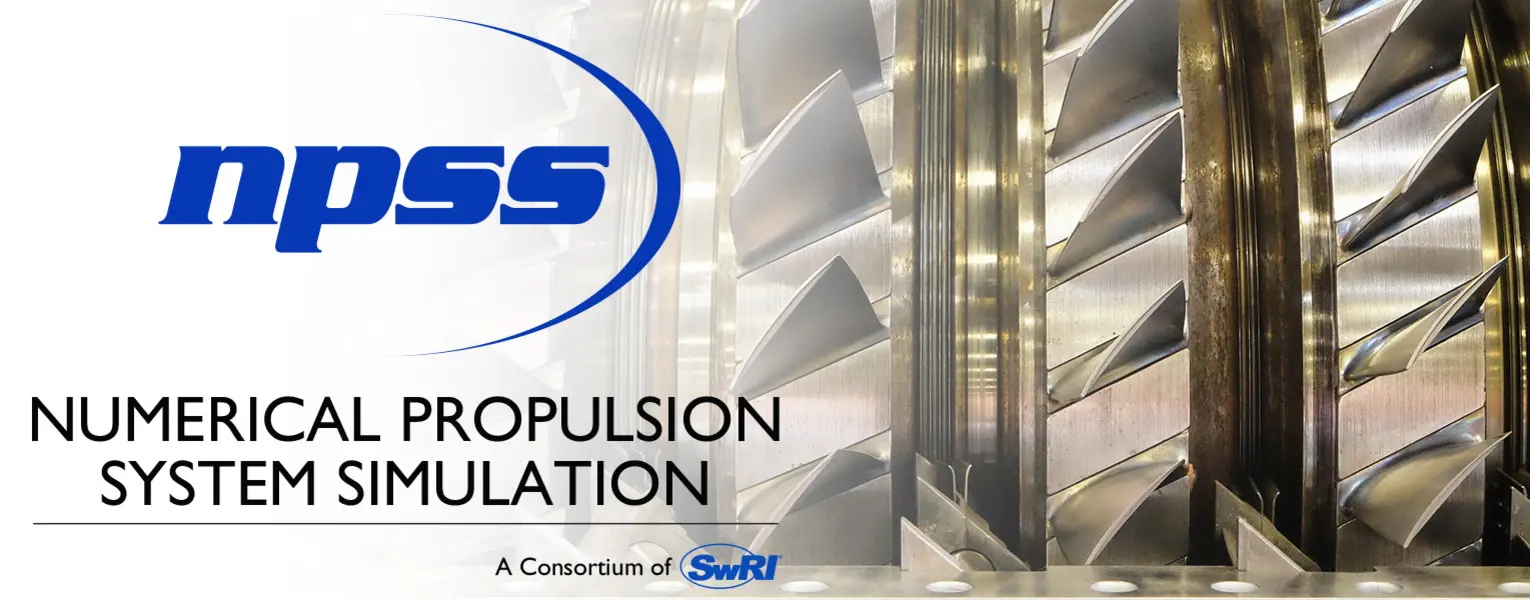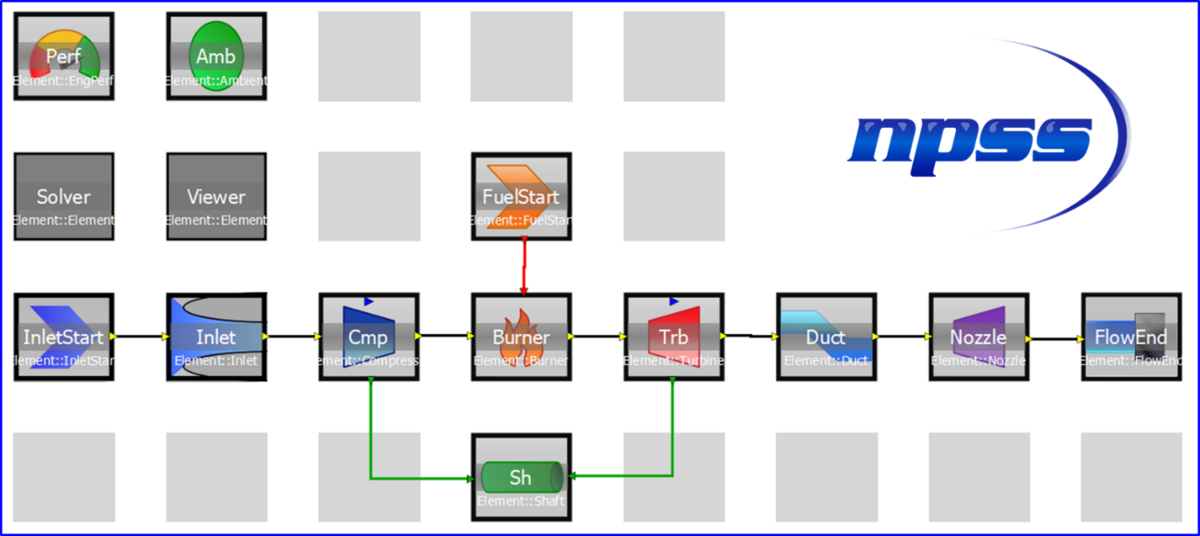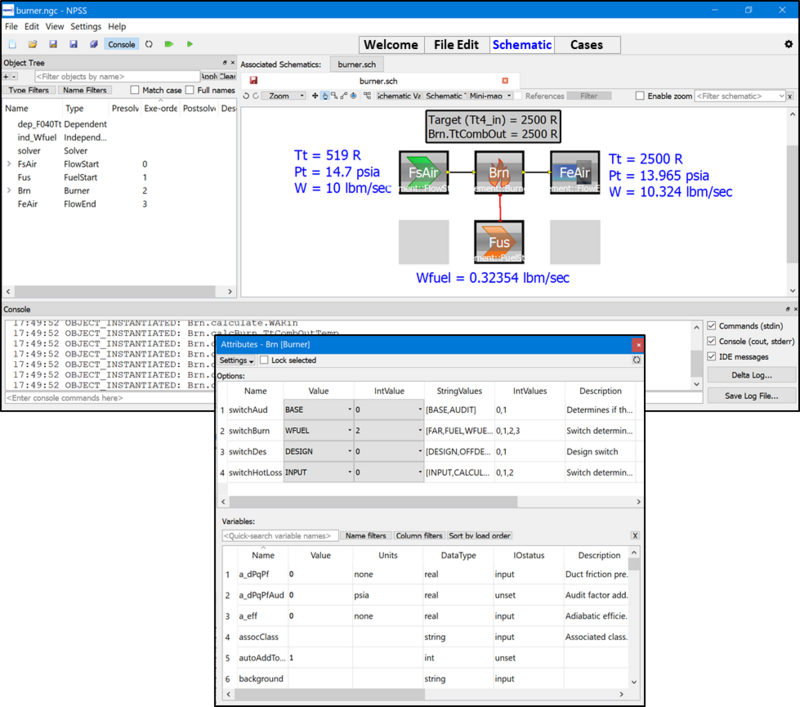NPSS® stands for Numerical Propulsion System Simulation. It is an advanced object-oriented, non-linear thermodynamic modeling environment used by the aerospace industry for modeling turbomachinery, air-breathing propulsion systems, liquid rocket engines, engine control systems, and system model integration. It can also be used for modeling refrigeration cycles, multi-phase heat transfer systems, vehicle emission analyses, or supercritical carbon dioxide (sCO2) power cycles. For a more comprehensive overview, see the About NPSS document.
The NPSS software was originally developed by engineers at NASA Glenn Research Center (GRC) in 1995. The original design intent for NPSS, which is still true today, was for the development of engine performance models that can be integrated into vehicle system models. In this way, engine manufacturers can share critical performance information in a manner that can be easily incorporated into a system model by the airframe builder. Circa 2007, NASA GRC signed over control of maintenance and development for the code to an industrial consortium, organized and operated by the NPSS Consortium Members. In 2013, the Consortium Members transferred management responsibility of the consortium to SwRI.
Generic engine cycle model developed using NPSS. Some standard components include Inlet, Compressor, Burner, Turbine, Duct, and Nozzle
The NPSS IDE facilitates NPSS model development, interrogation, and visualization while maintaining the conventional NPSS functionality and versatility that the software is renowned for. NPSS is based on object-oriented programming, which facilitates user-definable elements and functions. Additionally, NPSS contains a library of NIST-compliant gas property packages for a variety of applications, a sophisticated solver with auto-setup, constraints, and discontinuity handling. Typical solution modes include preliminary design, off-design performance, transient performance, and flight test data correlation.
Screenshots from the NPSS IDE;
Primary application areas for NPSS include aerospace systems (i.e., engine performance models for aircraft propulsion), thermodynamic system analysis such as Rankine and Brayton cycles, various rocket propulsion cycles, and industry standardization for model sharing and integration.
Current NPSS Consortium Members
NPSS Development Projects
The NPSS Consortium manages three development project areas in support of the NPSS user community: NPSS Core, NPSS IDE, and NPSS EMI. These project areas are organized to support key development themes established by the Governing Board of the NPSS Consortium. Consortium members receive all of the latest NPSS development products, including the latest fixes to the NPSS Core, newest features in the NPSS IDE, and under-development examples in NPSS EMI. For example, a python interface and an example of a rocket propulsion cycle are available to Consortium members only.
NPSS Core
The NPSS Core project is focused solely on software updates, bug fixes, and new features for the NPSS software environment. This includes the various functions of the NPSS interactive environment, converters for developing compiled content, standardized functions that support model development and operation, and numerical routines used by the solver for steady-state and transient solutions.
SwRI’s NPSS development team has been adding new capabilities and addressing bugs since the release of NPSS v2.6.1 in December 2013. Among some of the early updates were the ability to specify a unit system, support 64-bit runtimes under Windows® and Linux® operating systems, and enhanced tracking of file dependencies and object hierarchies. Furthermore, feedback from our NPSS-user community has prompted improvements in documentation, reduced memory footprint, and increased execution speeds. The most recent release of the NPSS software, v3.2, continues to address user feedback, including additional documentation improvements, combined FlowStation classes, thermodynamic package fixes, and additional improvements to the NPSS interactive environment. See the Release Notes for additional explanations about the various improvements included in the latest NPSS Core release.
NPSS IDE
As described above, the NPSS IDE is a new tool developed by the NPSS Consortium. It was released publicly in 2020. The purpose of the NPSS IDE is to make the NPSS software more accessible to new and casual users. However, advanced users will also find the tool useful, because it eases the process of developing new models and investigating the structure of existing unfamiliar models.
NPSS EMI
NPSS EMI contains examples of NPSS [E]lements, [M]odels, and [I]nterfaces. The focus of the NPSS EMI project is to independently manage, maintain, and develop the engineering functions associated with NPSS. Therefore, EMI releases can occur independent of NPSS Core releases.
Example [E]lements contain the engineering code that defines the behavior of various cycle components. A few examples of standard elements included in EMI include a compressor, turbine, duct, and burner.
The example [M]odels in this project are intended to be demonstration models that can be used for training purposes or for the development of new models. A few of the example models included in EMI are air-breathing engine propulsion cycles, a mission analysis model, a refrigeration cycle model, and examples of building customer decks.
[I]nterfaces are crucial for sharing NPSS models with other companies, users, and toolsets. For example, NPSS developers can integrate models with various tools to complete design studies, optimization studies, or conduct hardware-in-the-loop analyses. The intent of the interface examples is to provide clear documentation about how to implement these interfaces.
How to Get NPSS or Request NPSS Support
SwRI manages the NPSS Consortium on behalf of the Consortium members. Thus, you can purchase a NPSS license online via SwRI’s NPSS License page. Since NPSS is export controlled, the sale of NPSS licenses is restricted to countries not currently listed on the U.S. Department of Commerce Anti-Terrorism watch list.
For users or companies with significant experience using NPSS, or for companies with a large user base, Consortium membership may be beneficial. Members enjoy all the features of the commercial software, plus access to the full source code (a significant value for building the source to fit your own computing resources), unlimited NPSS licenses, opportunity to contribute towards defining future NPSS development efforts, and the legal right to sub-license NPSS to sub-contractors and vendors for the purpose of model sharing.
To contract SwRI for any NPSS modeling or development needs, for questions about the software, or for additional information about consortium membership, send an email to the NPSS Consortium Manager, contact Griffin Beck or call +1 210 522 2509.
Selected References
M. L. Belair, C. J. Sarmiento and T. M. Lavelle, "Nuclear Thermal Rocket Simulation in NPSS," American Institute of Aeronautics and Astronautics, Cleveland, OH, 2014.
T. L. Benyo, "Flow Matching Results of an MHD Energy Bypass System on a Supersonic Turbojet Engine Using the Numerical Propulsion System Simulation (NPSS) Environment," 42nd Plasmadynamics and Lasers Conference sponsored by the American Institute of Aeronautics and Astronautics, Honolulu, Hawaii, 2011.
G. Follen and M. auBuchon, "Numerical Zooming Between a NPSS Engine System Simulation and a One-Dimensional High Compressor Analysis Code," Computational Aerosciences Workshop sponsored by the High Performance Computing and Communications Program, Moffett Field, California, 2000.
E. J. Hall, J. Rasche, T. A. Simons and D. Hoyniak, "NPSS Multidisciplinary Integration and Analysis," Prepared under Contract NAS3–98003, Task 5, Cleveland, OH, 2006.
E. S. Hendricks and M. T. Tong, "Performance and Weight Estimates for an Advanced Open Rotor Engine," 48th Joint Propulsion Conference and Exhibit cosponsored by the AIAA, ASME, SAE, and ASEE, Atlanta, Georgia, 2012.
P. K. Johnson and D. S. Hervol, "Experimental Validation of a Closed Brayton Cycle System Transient Simulation," Glenn Reserarch Center, Lewis Field, Cleveland, OH, 2006.
S. M. Jones, "An Introduction to Thermodynamic Performance Analysis of Aircraft Gas Turbine Engine Cycles Using the Numerical Propulsion System Simulation Code," NASA Center for Aerospace Information, Hanover, MD, Cleveland, Ohio, 2007.
T. M. Lavelle, A. K. Owen and B. C. Huffman, "Using the NPSS Environment to Model an Altitude Test Facility," National Aeronautics and Space Administration, Cleveland, OH, 2013.
J. K. Lytle, "The Numerical Propulsion System Simulation: A Multidisciplinary Design System for Aerospace Vehicles," 14th International Symposium on Air Breathing Engines sponsored by the International Society for Air Breathing Engines, Florence, Italy, 1999.
L. D. Nichols and C. C. Chamis, "Numerical Propulsion System Simulation: An Interdisciplinary Approach," Conference on Advanced Space Exploration Initiative Technologies, Cleveland, OH, 1991.
K. I. Parker, J. L. Felder, T. M. Lavelle, C. A. Withrow, A. Y. Yu and W. V. Lehmann, "Integrated Control Modeling for Propulsion Systems Using NPSS," JANNAF, Colorado Springs, CO, 2004.
J. P. Veres, P. C. Jorgenson and S. M. Jones, "Modeling the Deterioration of Engine and Low Pressure Compressor Performance During a Roll Back Event Due to Ice Accretion," 50th Joint Propulsion Conference cosponsored by AIAA, ASME, SAE, and ASEE, Cleveland, Ohio, 2014.




